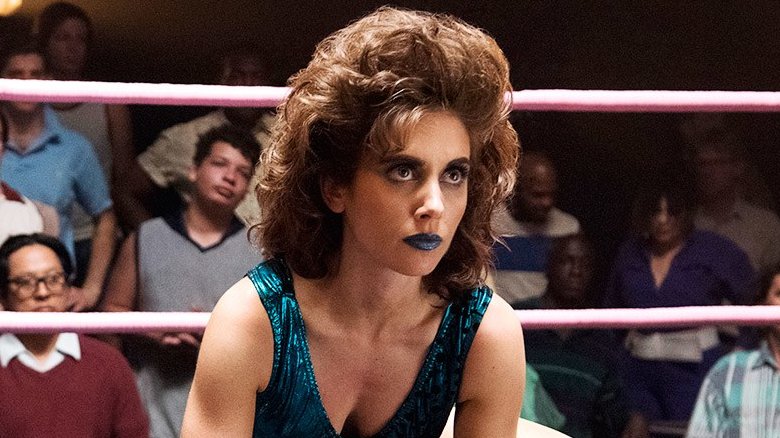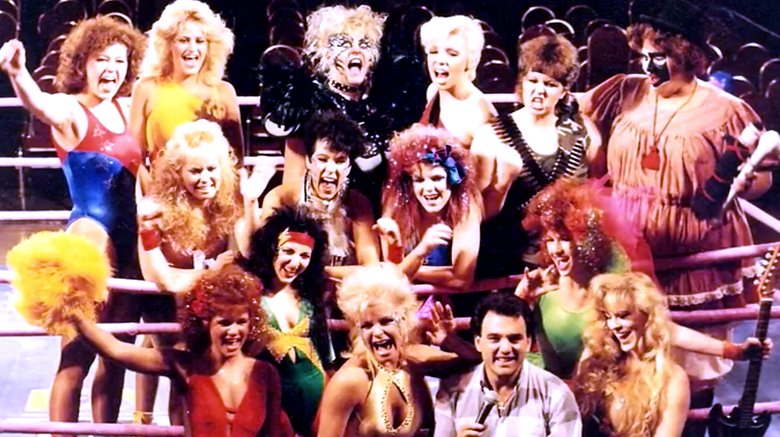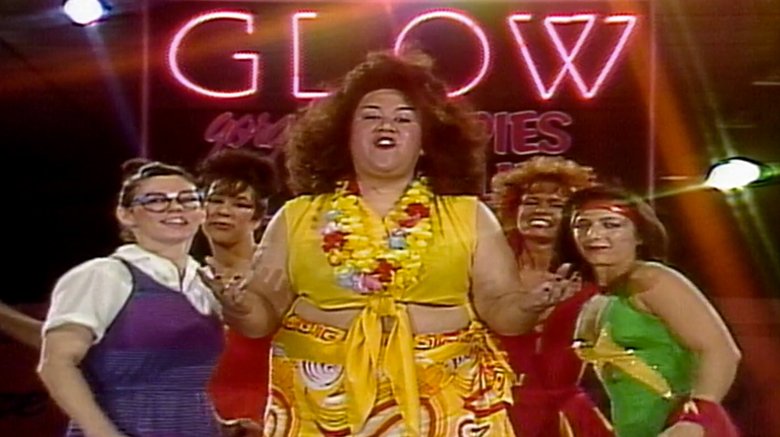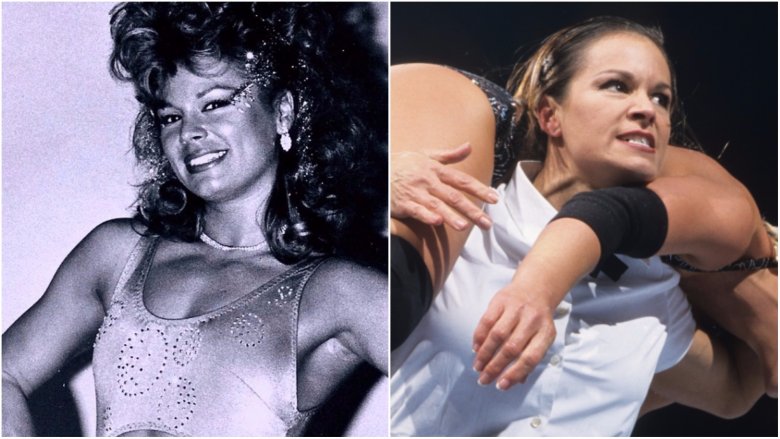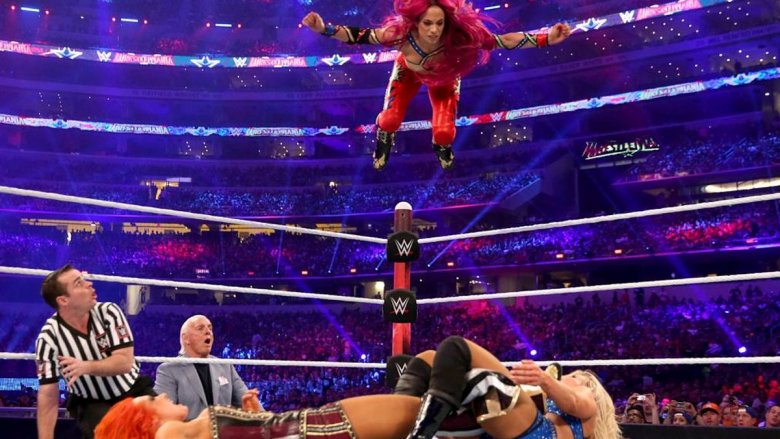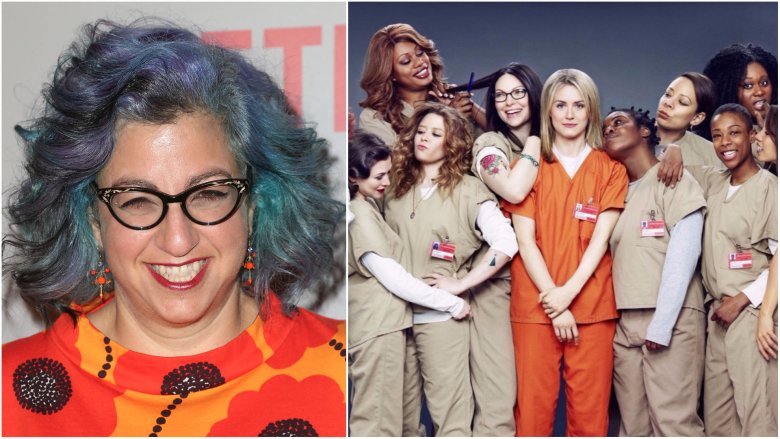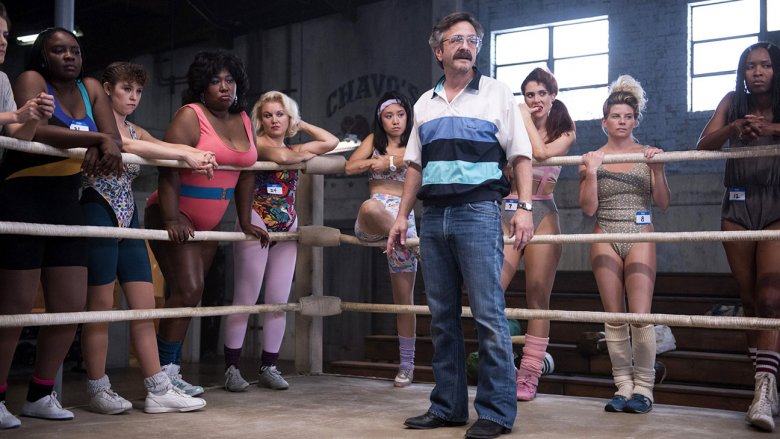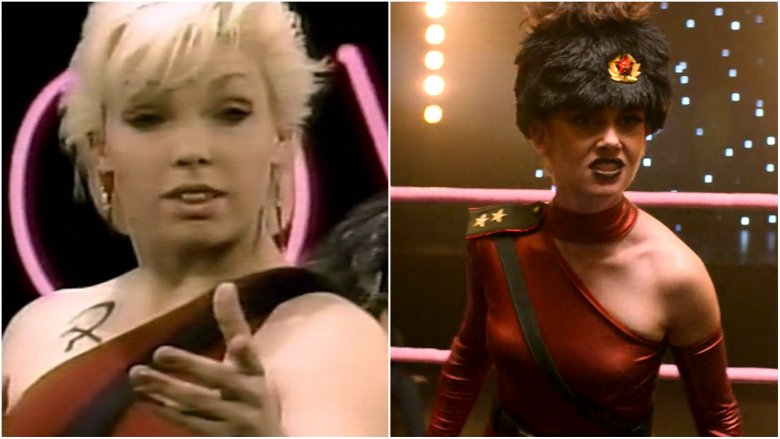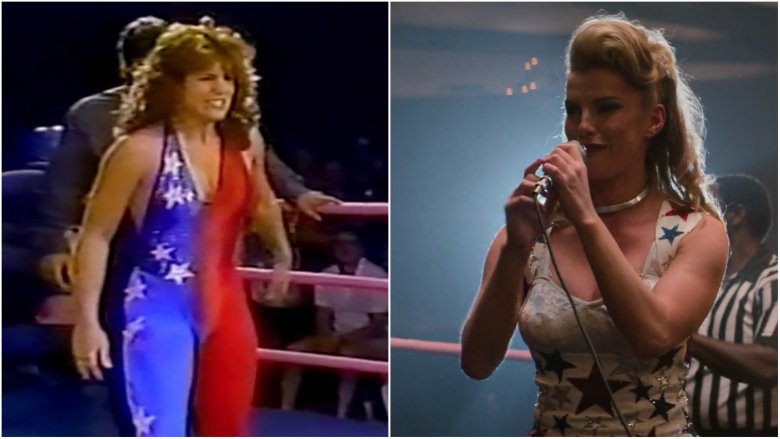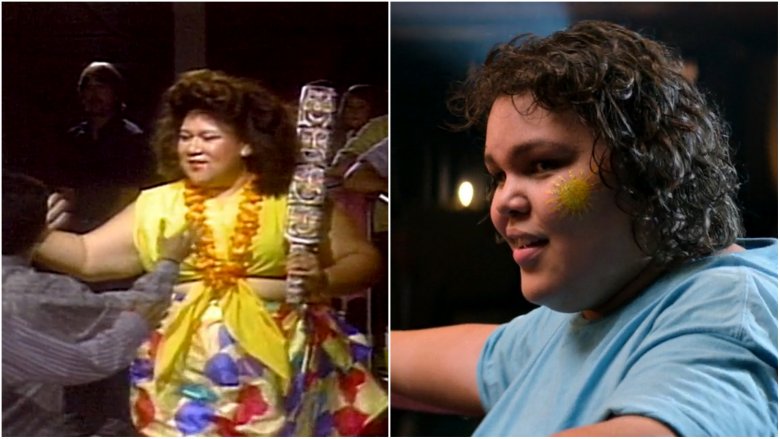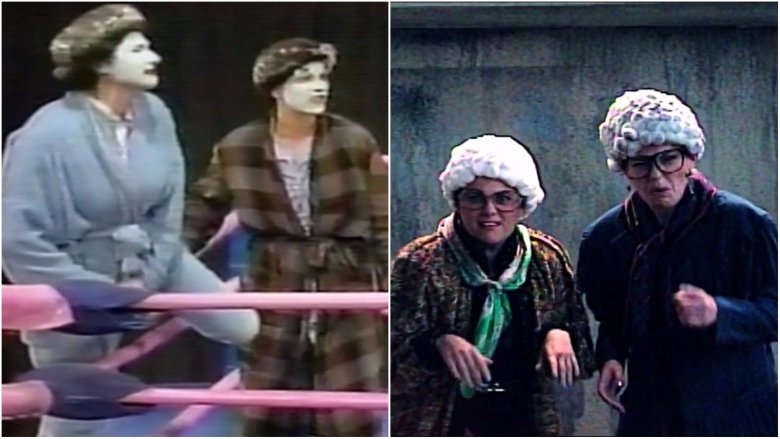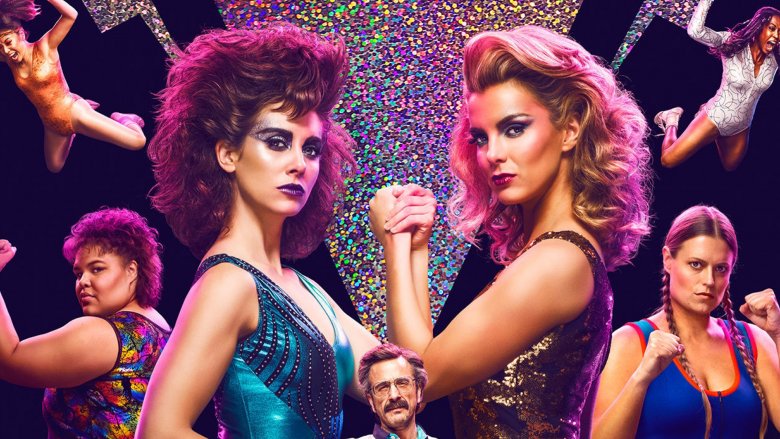The Untold Truth Of GLOW
If you're like a lot of Netflix viewers, you binged the first season of GLOW the weekend it came out, maybe the first day. And the show may have left you with questions. Wasn't there a real wrestling TV show called GLOW in the 1980s? What does this GLOW have to do with the real one? If there was a real GLOW, does that mean the characters on the Netflix show are real people? And what's the deal with women's wrestling anyway?
In the interest of taking a load off your mind so you can move on to the next Netflix binge, here's a quick look at the history of both versions of GLOW—and just what the new show has in common with the original.
The origin of GLOW
In the mid-1980s, women's wrestling got no respect. When women appeared at pro wrestling events at all, they were treated like an oddity or a side show. Promoter David McClane had the unpopular idea to fill a wrestling show entirely with women, and started holding auditions in Los Angeles. Most of the women recruited had no experience wrestling, but they'd receive training from Mando Guerrero and Cynthia Peretti—and anyway, GLOW was never intended as a showcase of technical wrestling skill. It was about characters and comedy and over-the-top good-versus-evil melodrama.
GLOW stood for Gorgeous Ladies of Wrestling, and each of the ladies in the company developed a character she'd portray in and out of the ring. The women were divided into the super-heroines and arch-villainesses of GLOW, with the good girls including the patriotic Americana, glamorous Tina Ferrari, and Island Goddess Mount Fiji. Bad girls included the Voodoo Priestess Big Bad Mama, Soviet superwoman Ninotchka, and the fascistic Matilda the Hun.
Meanwhile, McClane brought in TV producer Irv Holender to help develop GLOW as a syndicated TV show, businessman Meshulam Riklis to produce and provide a ritzy-looking venue in Las Vegas, and B movie filmmaker Matt Cimber to direct.
Women's wrestling in 1986
GLOW made its television debut in 1986 and was a surprise hit. Kids loved the silly tone and cartoonish characters, teens and college students loved the camp sensibility, and certainly plenty of viewers were in it for the attractive women in skimpy outfits. GLOW was unlike anything else that existed at the time, and that alone brought it attention.
Wrestling in 1986 was dominated by Hulk Hogan, the top star of the WWF. As of GLOW's premiere, Hogan and the other top wrestlers were starring in their own TV cartoon. There was women's wrestling in the WWF, but it was mostly dominated by the Fabulous Moolah, a woman in her 60s. Wendi Richter had been a promising young wrestler in 1985, but when she had contract issues with the WWF, they brought in Moolah to take the title from her and that was that. Meanwhile, Jim Crockett Promotions and the NWA, the only other wrestling organization with anything like a national TV presence, wasn't putting women on its shows at all.
So David McClane was right, as it turned out. There was an audience for women's wrestling that wasn't being served at all, and GLOW catered to it perfectly, silly though it might have been.
GLOW's end and its legacy
Unfortunately, finding an audience isn't all it takes for a show to be successful—it also needs to be reasonably well run. After the first two seasons, McClane and many of the wrestlers left GLOW because they felt Matt Cimber's attempts at comedy were too lowbrow. Cimber hired more performers and the show continued until 1990, when it went off the air for largely unexplained reasons, despite continued TV success. There was talk of financial problems, as well as a rumor that Pia Zadora, wife of producer Meshulam Riklis, had demanded he end the show because he kept flirting with the wrestlers. Whatever the reason, that was the end of GLOW. There were a few attempts at revivals or revamps over the next couple of decades, but nothing ever came of them.
One GLOW wrestler who had continued success in the field was Tina Ferrari, one of the most popular of the good girls, whose real name was Lisa Moretti. Moretti kept wrestling after GLOW ended and eventually found her way to the WWF, where she wrestled under the name Ivory. She held the Women's Championship three times, and only had to lose it to the Fabulous Moolah once. She also got to feud with women's wrestling legends like Chyna, Lita, and Jazz. She was a major part of the fondly remembered "Right to Censor" storyline, in which a faction of bad guys attempted to crack down on the sex and violence in wrestling.
Women wrestlers on the rise
As the 21st Century dawned, GLOW was mostly forgotten. Women's wrestling, on the other hand, was on the upswing. Shimmer Women Athletes, the most prominent all-women wrestling company in the US, was founded in 2005. Shine Wrestling, a Florida-based sister company, launched in 2012. If both company's names have a familiar theme, that's probably not a coincidence. Combat Zone Wrestling, a popular indie company, also has their own all-women sister promotion, Women Superstars Uncensored, which is not nearly as dirty as its name makes it sound. Other prominent indie wrestling companies, such as Chikara and Inspire Pro Wrestling, also treat their female performers with respect and give them space alongside the men.
WWE, the globally dominant company once known as the WWF, have also gotten better (in fits and starts) at presenting women's wrestling. A generation of talented female wrestlers have basically forced their hand on the issue, exhibiting such talent and promise that the company has little choice but to show them respect. In 2016, a three-way match between Sasha Banks, Charlotte Flair, and Becky Lynch was widely regarded as the highlight of Wrestlemania 32. It was also there that the pink, butterfly-shaped "Divas Championship" was replaced with a more appealing red and white "Women's Championship." WWE hasn't always done a great job booking their women, but the current crop of female talent has attracted such a fanbase that the company definitely hears about it when they mess up.
And then there was Netflix
But in this world where women's wrestling is more of a thing than it's ever been, there was somehow no GLOW—an absence highlighted in 2012, when the documentary GLOW: The Story of the Gorgeous Ladies of Wrestling reunited many of the original performers and told the story of the rise and fall of the company in the '80s, introducing GLOW to many viewers who'd never seen it before.
And then Jenji Kohan came along. Kohan had created the popular Showtime series Weeds, and followed that up with one of Netflix's first big hits, Orange is the New Black. In 2016, news broke that Kohan's next show would be a new version of GLOW for Netflix. Kohan was just brought on as a producer, however; the creators of the new show are Carly Mensch, who worked with Kohan on Weeds and OitNB, and Liz Flahive, who worked with Mensch on Nurse Jackie.
A whole new GLOW
It became clear fairly quickly that the new GLOW wouldn't be a wrestling show. Rather, it's a narrative comedy about wrestling. The regular cast includes only one wrestler: Kia Stevens, better known as Awesome Kong. The actresses who played the other wrestlers did receive in-ring training from Chavo Guerrero Jr., the nephew of Mando Guerrero, who trained the original GLOW wrestlers; however, none of the characters in the show could be directly based on those original performers or their wrestling personas. It seems that the rights Netflix and the producers obtained only extended to the Gorgeous Ladies of Wrestling name, not the individual characters.
The central stars of Netflix's GLOW are Alison Brie, Marc Maron, and Betty Gilpin. Brie and Gilpin play best friends who have a falling out and then become the wrestling show's top hero and villain. Maron plays the director, who obviously has a bit of Matt Cimber in him, but who seems to have more artistic aspirations than Cimber ever demonstrated.
As for the wrestlers, their real lives as portrayed in the show are clearly entirely fictional. On the other hand, most of the wrestling characters they take on are recognizably based on characters from the original GLOW, even though they can't use the names. For example, glamour queen Melrose is obviously based on a character named Hollywood, from the crimped hair to the L.A.-based name. Here's a look at some of the characters from Netflix's GLOW side-by-side with their 1980s counterparts.
Socialist Superwoman
Alison Brie's character, Ruth, takes herself very seriously as an actress. Perhaps because of that, it takes her the longest to find her character. Knowing she's meant to be the company's top villain, she settles on becoming Zoya the Destroyer, an America-hating Russian military super-athlete. Unsurprisingly, evil Russians were incredibly common as wrestling villains in the 1980s, and GLOW had one of the best. Colonel Ninotchka was played by Lorilyn Palmer, and remains one of the most fondly remembered GLOW characters. Palmer, who was no more Russian than Brie, also helped train the later recruits to the GLOW roster.
Miss American Pie
Every anti-American supervillain needs an American superhero to thwart their evil deeds, of course. Betty Gilpin's character Debbie is a former soap opera actress who gets recruited specifically to play the top hero in GLOW. As such, she becomes Liberty Belle, the embodiment of all that's good and clean and strong about America. Cindy Maranne, who played Americana on the original GLOW, was a bit less glam but every inch as all-American.
The Lovable Giant
One of the most popular characters on the original GLOW was Mt. Fiji, a plus-size heroine played by Olympic shot putter Emily Dole. Dole is Samoan-American, and Fiji basically embodied every generic "island" stereotype. But it was Dole's natural charisma that made the character work. On the new GLOW, her mantle is carried by Britney Young as Carmen, a shy but friendly woman from a family of wrestling giants who takes on the South American character, Machu Picchu.
Weird Old Ladies
In the original GLOW, sisters Sharon and Donna Willinsky played the Housewives, a tag team of two old ladies in housecoats who looked down on all the young wrestlers in their skimpy outfits and called them names. Similarly, the new GLOW features Kimmy Gatewood and Rebekka Johnson as the Beat-Down Biddies, a pair of Sophia Petrillo lookalikes who enter with walkers. Interestingly, the Wilinsky sisters soon changed characters entirely to become the Heavy Metal Sisters, Spike and Chainsaw, so it would be interesting to see the Biddies go through a similarly stark transformation in GLOW Season 2.
From the old GLOW to the new
Despite these and other similarities, the new GLOW differs from the original about as much as it could, starting with not being a wrestling show, although it does feature some wrestling. Both shows feature comedy, but the new one still falls within the realm of what we might call prestige television, while the original is shameless 1980s schlock.
And yet, the attitude of the new GLOW toward the old GLOW feels entirely affectionate. Mensch and Flahive are using the structure of a wrestling show to tell a story about failure and resilience and women's lives, and that's great. But there are also moments when it feels like they're paying loving homage to the original GLOW, and to wrestling in general, and that's great too. The new GLOW may not be a wrestling show, but it might still be the best possible show to help people understand what wrestling is all about.
